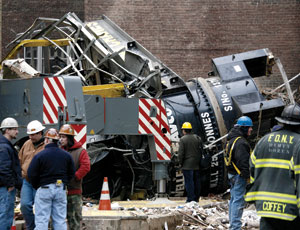The manslaughter trial began on June 22 for a New York City crane rigger accused of causing a 2008 crane collapse in midtown Manhattan that killed seven, including the entire rigging crew and a civilian. The Manhattan district attorney has maintained that William Rapetti and his company, Rapetti Rigging Ser-vices, Massapequa Park, N.Y., are responsible for the March 15, 2008, collapse. But the defense team continually has pushed to prove other causes, claiming Rapetti did not do “anything wrong” in preparing the 200-ft tower crane to be “jumped,” or extended, from the 18th floor of a rising condo on East 51st Street. Rapetti, 49, was licensed by the city’s Dept. of Buildings (DOB) to supervise crane jumps and was a member of Local 14 of the operating engineers’ union. He was indicted in 2009 on multiple charges of manslaughter, criminally negligent homicide, assault and reckless endangerment. If convicted, he could face up to a total of 27 years in prison.

Throughout opening arguments and much of the first week of testimony, Manhattan Assistant District Attorney Sean Sullivan, using reports from both the DOB and the U.S. Occupational Safety and Health Administration, claimed that, during the jumping process, Rapetti used four nylon slings to secure the crane’s six-ton steel collar to its mast. The slings, prosecutors say, snapped because Rapetti “carelessly” and “recklessly” failed to follow the manufacturer’s Favelle Favco M440E crane specifications, which called for eight slings. In addition, prosecutors have alleged that at least one of the slings was sun-faded, torn and improperly tied to edges and corners.
Earlier in the week, the prosecution’s argument took a hit when its own witness, concrete laborer Rosario Galluzzo, testified he was the last person to handle the slings before the accident. He said the slings were all ordered new and that he remembered removing the bright-yellow slings from the plastic “with [his] own fingers,” adding he “never saw them snapped or cut.” Galluzzo did say, though, that he and other workers heard “material”—not metal —“snap,” and they saw the crane “jiggle” before it fell. “For a few seconds, we’re looking at each other, [thinking], ‘What the hell was that?’ ” he recalled. “Then the collar went down.”
Rapetti’s attorney, Arthur Aidala, also has refuted the DOB and OSHA reports maintaining the collapse was caused by several different factors, including the crane’s not being bolted to the ground due to a cost-cutting measure made by the building’s owner in order to save $250,000 on the project. Instead, Aidala said, the crane was held in place only by friction.

RAPETTI
“Before March 15, this crane was already falling down. They were walking into an ambush that day,” Aidala told Judge Roger Hayes.
The case is being heard only by Hayes, as Rapetti requested not to be tried by a jury.
Aidala also raised the question of whether or not the site supervisor for the project’s lead contractor, Joy Contractors, Elizabeth, N.J., was even on-site at the time the crane was being jumped.
New York City police officer Tom Carpenter, who was working crowd control at a St. Patrick’s Day-themed “bar crawl” a block away from the site, testified he saw several men in hardhats racing to the site after the crane collapsed. The men had been hanging around near the throngs of bar-crawl “revelers,” Carpenter said.
While questioning OSHA’s Manhattan-area director, Richard Mendelson, Aidala said one of the men was Joy Contractors’ site supervisor—a claim backed by testimony from Galluzzo, who said, “The bosses weren’t there.”
High winds were a third possible cause of the collapse brought up by Aidala. A March 15 National Weather Service report forecast sustained gusts of 20 mph, which was the maximum speed allowed for jumping, according to the manufacturer’s manual.

Post a comment to this article
Report Abusive Comment